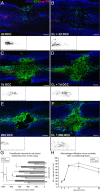Overcoming macrophage-mediated axonal dieback following CNS injury
- PMID: 19675231
- PMCID: PMC2771342
- DOI: 10.1523/JNEUROSCI.1151-09.2009
Overcoming macrophage-mediated axonal dieback following CNS injury
Abstract
Trauma to the adult CNS initiates multiple processes including primary and secondary axotomy, inflammation, and glial scar formation that have devastating effects on neuronal regeneration. After spinal cord injury, the infiltration of phagocytic macrophages coincides with long-distance axonal retraction from the initial site of injury, a deleterious phenomenon known as axonal dieback. We have previously shown that activated macrophages directly induce long-distance retraction of dystrophic axons in an in vitro model of the glial scar. We hypothesized that treatments that are primarily thought to increase neuronal regeneration following spinal cord injury may in fact derive a portion of their beneficial effects from inhibition of macrophage-mediated axonal retraction. We analyzed the effects of protease inhibition, substrate modification, and neuronal preconditioning on macrophage-axon interactions using our established in vitro model. General inhibition of matrix metalloproteinases and specific inhibition of MMP-9 prevented macrophage-induced axonal retraction despite significant physical interactions between the two cell types, whereas inhibition of MMP-2 had no effect. Chondroitinase ABC-mediated digestion of the aggrecan substrate also prevented macrophage-induced axonal retraction in the presence of extensive macrophage-axon interactions. The use of a conditioning lesion to stimulate intrinsic neuronal growth potential in the absence of substrate modification likewise prevented macrophage-induced axonal retraction in vitro and in vivo following spinal cord injury. These data provide valuable insight into the cellular and molecular mechanisms underlying macrophage-mediated axonal retraction and demonstrate modifications that can alleviate the detrimental effects of this unfavorable phenomenon on the postlesion CNS.
Figures








Similar articles
-
Another barrier to regeneration in the CNS: activated macrophages induce extensive retraction of dystrophic axons through direct physical interactions.J Neurosci. 2008 Sep 17;28(38):9330-41. doi: 10.1523/JNEUROSCI.2488-08.2008. J Neurosci. 2008. PMID: 18799667 Free PMC article.
-
Adult NG2+ cells are permissive to neurite outgrowth and stabilize sensory axons during macrophage-induced axonal dieback after spinal cord injury.J Neurosci. 2010 Jan 6;30(1):255-65. doi: 10.1523/JNEUROSCI.3705-09.2010. J Neurosci. 2010. PMID: 20053907 Free PMC article.
-
Multipotent adult progenitor cells prevent macrophage-mediated axonal dieback and promote regrowth after spinal cord injury.J Neurosci. 2011 Jan 19;31(3):944-53. doi: 10.1523/JNEUROSCI.3566-10.2011. J Neurosci. 2011. PMID: 21248119 Free PMC article.
-
A view from the ending: Axonal dieback and regeneration following SCI.Neurosci Lett. 2017 Jun 23;652:11-24. doi: 10.1016/j.neulet.2016.11.002. Epub 2016 Nov 5. Neurosci Lett. 2017. PMID: 27825985 Review.
-
Macrophage phagocytosis after spinal cord injury: when friends become foes.Brain. 2021 Nov 29;144(10):2933-2945. doi: 10.1093/brain/awab250. Brain. 2021. PMID: 34244729 Review.
Cited by
-
Blockade of interleukin-6 signaling inhibits the classic pathway and promotes an alternative pathway of macrophage activation after spinal cord injury in mice.J Neuroinflammation. 2012 Feb 27;9:40. doi: 10.1186/1742-2094-9-40. J Neuroinflammation. 2012. PMID: 22369693 Free PMC article.
-
RNA Interference Unleashed: Current Perspective of Small Interfering RNA (siRNA) Therapeutics in the Treatment of Neuropathic Pain.ACS Pharmacol Transl Sci. 2024 Sep 23;7(10):2951-2970. doi: 10.1021/acsptsci.4c00329. eCollection 2024 Oct 11. ACS Pharmacol Transl Sci. 2024. PMID: 39416962 Review.
-
Chondroitinase ABC promotes recovery of adaptive limb movements and enhances axonal growth caudal to a spinal hemisection.J Neurosci. 2011 Apr 13;31(15):5710-20. doi: 10.1523/JNEUROSCI.4459-10.2011. J Neurosci. 2011. PMID: 21490212 Free PMC article.
-
Fibronectin inhibits chronic pain development after spinal cord injury.J Neurotrauma. 2012 Feb 10;29(3):589-99. doi: 10.1089/neu.2011.2059. Epub 2012 Jan 13. J Neurotrauma. 2012. PMID: 22022865 Free PMC article.
-
Taxol facilitates axon regeneration in the mature CNS.J Neurosci. 2011 Feb 16;31(7):2688-99. doi: 10.1523/JNEUROSCI.4885-10.2011. J Neurosci. 2011. PMID: 21325537 Free PMC article.
References
-
- Baba T, Iwasaki S, Maruoka T, Suzuki A, Tomaru U, Ikeda H, Yoshiki T, Kasahara M, Ishizu A. Rat CD4+CD8+ macrophages kill tumor cells through an NKG2D- and granzyme/perforin-dependent mechanism. J Immunol. 2008;180:2999–3006. - PubMed
-
- Bradbury EJ, Moon LD, Popat RJ, King VR, Bennett GS, Patel PN, Fawcett JW, McMahon SB. Chondroitinase ABC promotes functional recovery after spinal cord injury. Nature. 2002;416:636–640. - PubMed
-
- Busch SA, Silver J. The role of extracellular matrix in CNS regeneration. Curr Opin Neurobiol. 2007;17:120–127. - PubMed
-
- Chandler S, Miller KM, Clements JM, Lury J, Corkill D, Anthony DC, Adams SE, Gearing AJ. Matrix metalloproteinases, tumor necrosis factor and multiple sclerosis: an overview. J Neuroimmunol. 1997;72:155–161. - PubMed
Publication types
MeSH terms
Substances
Grants and funding
LinkOut - more resources
Full Text Sources
Other Literature Sources
Medical
Miscellaneous
